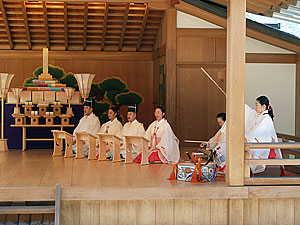Ethics education program captures
the spirit of Bankyo Dokon
By Bill Roberts
In what is likely a first, an interfaith group has designed, field-tested, and distributed an educational program to teach youths how to live an ethical life in the hope that it will nurture peace and reduce violence against children around the globe.
At its third quadrennial forum, held in Hiroshima, the Tokyo-based Arigatou Foundation and its Global Network of Religions for Children (GNRC) launched, “Learning to Live Together,” a toolkit of learning objectives, experience-based exercises, and other resources for educators around the globe to use with children of all ages to teach four values: respect, responsibility, reconciliation, and empathy.
Through a process of consensus, an interfaith committee of religious leaders, lay people and teachers from various religious traditions decided these four values are the basis of an ethical life in any religion or culture. Committee members emphasized repeatedly that the program is not religious education but designed to build bridges among religions. A book containing the program materials was released in English, French, and Spanish, with versions expected soon in Japanese, Arabic, and Swahili.
The program, which is the result of an effort begun in 2004, is subtitled, “An Intercultural and Interfaith Program for Ethics Education.” It was created by the Interfaith Council on Ethics Education for Children, which was founded by the Arigatou Foundation in 2004 as an international resource center for dialogue, partnership, and action, to promote ethics education for children and interfaith learning. The program was produced in cooperation with and endorsed by two United Nations agencies -- UNESCO and UNICEF.
The program was unveiled at the opening day of the GNRC’s Third Forum, attended by Mme. Kurenai Deguchi, the Spiritual Leader of Oomoto, which is a member of the GNRC, founded by the Arigato Foundation in 2000.
The essence of Bankyo Dokon
The GNRC represents the kind of activity promoted by Oomoto Co-Founder Onisaburo Deguchi (1871-1948) through the doctrine of Bankyo Dokon – “all religions spring from the same root.” Oomoto believes that God has been revealed to many people in many cultures throughout history in ways appropriate to each time and place; therefore, religions should have no conflict with each other and should work together to create God’s kingdom on earth.
Starting nearly a century ago, Oomoto began to organize, promote, and participate in interfaith programs as part of its sacred mission. Onisaburo organized what is believed to have been the first interfaith meeting of Asian religions in 1923 in Beijing. Involvement with the GNRC is congruent Oomoto’s longtime interfaith mission.
In keeping with the GNRC and Arigatou Foundation goal of combing prayer with practice, the three-day forum, held May 24 to May 26, 2008, included prayer and dialogue. It attracted 353 participants from more than 60 countries. At the opening and closing sessions they were joined by about 1,000 Japanese guests.
The largest portion of time was devoted to breakout groups, which identified priorities in three areas related to the welfare of children: to reduce violence against children; to ensure that no child lives in poverty; and to empower children to help protect the earth. Regional groups met to develop plans to meet these goals.
At the closing session, the participants expressed the belief that reducing violence, poverty and destruction of the earth can be achieved, in part, through widespread adoption of the ethics program. In their closing declaration they said: “By nurturing ethical awareness and promoting the common values of respect, empathy, responsibility and reconciliation, we believe this program will empower young people to respond to the threats of violence, poverty, and environmental destruction.”
The declaration also called for a “World Day of Prayer and Action for Children,” to be held each November 20, which is International Children’s Day and the date in 1989 when the United Nations General Assembly adopted the Convention on the Rights of the Child.
The declaration stated: “The call for prayer for children brings together our shared anguish at the suffering of children, and offers our collective hope for their dignity and integrity. And we recognize that every prayer comes with a new commitment to action.”
Full participation by children
Regarding the suffering of children, many speakers noted that it was appropriate to meet at the International Conference Center next to Hiroshima’s Peace Park, the place where the first atomic bomb was dropped on Aug. 6, 1945, killing mostly children, women, and elderly.
Children were full participants in the forum. More than 40 youths of all ages from five continents, joined by children from Hiroshima, attended a three-day, pre-forum event, and participated in the forum, making a presentation in the opening ceremony, taking part in breakout groups, offering prayers at plenary sessions, and providing two speakers for the closing. Many of the youths had been involved in field testing the ethics program. Test workshops were conducted in 10 countries with more than 300 youth from various religions and several of secular thinking.
In an introduction, the book “Learning to Live Together,” states that the program is “guided by an overall pledge to safeguard human dignity. Its aims are to strengthen children’s commitment to justice, respect for human rights, and to build harmonious relationships between individuals and within societies.”
The idea of values education can be controversial, especially in more secular nations, including the United States, where there is considerable polarization between people of faith and secularists, and polarization even among people of different faiths.
Creating an ethics program is a major accomplishment given the differences of language, scriptures, beliefs, values and culture specific to each religion. As panelists explained during a press conference, the program seeks to instill four values the interfaith committee agreed are universal to an ethical life.
“We didn’t want to compete with the teachings already going on in the religions,” said Agneta Ucko, director of Geneva-based Arigatou International and secretary general of the Interfaith Council on Ethics Education for Children. “It is important that we are not teaching religion or culture, but are using the program to bridge religions and cultures.”
During the nearly two years required to agree on objectives and content, committee members had to deal with several challenges, Ucko added. These included the fact that different religious traditions invest different levels of authority in their scriptures, refer to the supreme divinity by different names, and view good and evil, and the balance between the two, in different ways.
“Convening an inter-religious group to develop the program already took away some of these difficulties,” Ucko said. “Then as we started to develop the content, there was a focus on consensus. In terms of methodology, I think we all approached the task with the idea of some kind of interactive and participatory methodology.”
Positive reaction from teachers and students
The exercises are experience-based, and drawn from many cultures, with follow up discussion among students. The creators see the program as a work in progress. More than one person involved stated that it is certain to evolve as more teachers and facilitators use it in public and religious schools, youth organizations and other venues.
To learn more, visit the program’s web site.
“The materials can be picked up by teachers, changed as need be, and flexible enough for primary or secondary setting,” said Vinod Hallan, a regional adviser for educational strategies for the British government. “The teachers can add to the resources, and the idea is that they will add to the resources and develop their own bank.”
Hallan, an Indian-born naturalized British citizen, is one of the many educators who gave feedback to early drafts of the program, and observed early testing of some exercises. In an interview, he said reactions from teachers in Britain were generally positive. A day-long event in the town of Solihull, outside Birmingham, which brought together high school students of different social classes and religions (Christians, Muslims, Hindus, Sikhs, and secularists), to try some of the exercises, was well received, too.
The British government is making an effort to encourage the development of community cohesion, Hallan said. As a result, educators and parents are hungry for tools to help teach children respect for others: “It is a good time in England for a program like this, because the schools are receptive to any support. This document is going to be useful.”
One of the program committee members was Dr. A. T. Ariyaratne, founder and president of Sri Lanka’s Sarvodaya Shramadana Movement, and a well known interfaith layperson who is Buddhist. In the press conference, he was asked what obstacles he saw to disseminating the program in his country.
Language was the only one, he noted, and quickly added: “I decided this morning to translate it into the two languages we use in Sri Lanka and make at least 15,000 copies and make them available to 15,000 places. We are not trying to establish a new organization to do this but to use existing organizations to teach these things.”
Nobel laureate and award-winning actress
The forum heard from many other notable religious leaders, laypeople, and children’s activists. Speakers included the Rev. Takeyasu Miyamoto of Japan, leader of the Myochikai Buddhist lay organization, founder and president of the Arigato Foundation, and inaugurator of the GNRC; Adolfo Perez Esquivel of Argentina, a Nobel Peace Laureate; Asha-Rose Migiro of Tanzania, deputy secretary general of the United Nations; Ann Veneman of the U.S., executive director of UNICEF; and Yohei Kono, speaker of Japan’s House of Representatives.
There were also appearances by entertainers. Sarah Jones, a Tony Award-winning American stage actress, playwright and UNICEF spokesperson on violence against children, closed the opening session with a humorous but pointed monologue to illustrate how prejudices can get the best of people even when they have good intentions.
Raffi Cavoukian, known to millions of children as Raffi the Troubadour, entertained a delighted crowd at the first night’s reception. A Canadian citizen born in Egypt and longtime children’s advocate, Raffi obviously came not just to entertain but to get involved: He was seen participating in the breakout sessions.
Despite the appearances by notables, two teenagers stole the show at the closing session. Anam Wasey of India and Isaac Lukumayi Peter of Tanzania were chosen by their peers to represent the thoughts of the children in the final panel discussion. Both received vigorous applause, especially Peter when he implored the world to stop making weapons. “The developed countries that produce bombs, please stop producing bombs,” he said.
After the closing panel discussion, a representative from each religion in attendance, including the Rev. Kunihiko Shimamoto, Chief Director of Oomoto, offered a prayer for peace. Everyone then walked into the Peace Park to lay flowers at the Cenotaph which houses the eternal flame. The walk was led by the Rev. Miyamoto, who despite being 91 years old seemed ageless during his numerous appearances over the three-day event.
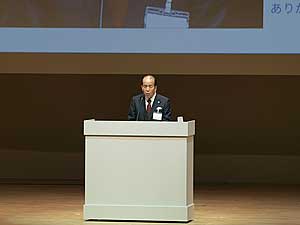
The Rev. Takeyasu Miyamoto, president of the Arigato Foundation, addresses the opening session of the GNRC’s Third Forum.
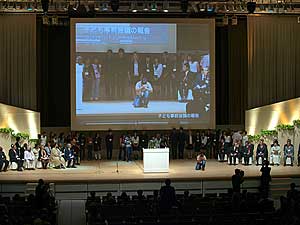
Youth participants dramatize their concerns over violence, poverty and destruction of the earth.
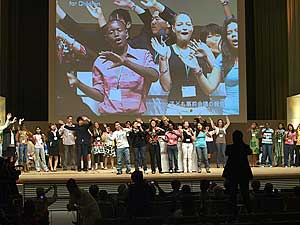
“We are the world, we are the children.”
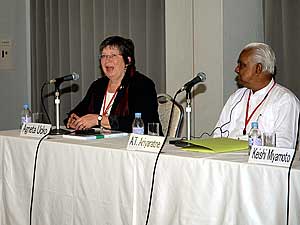
Agneta Ucko and Dr. A. T. Ariyaratne take questions in a press conference.
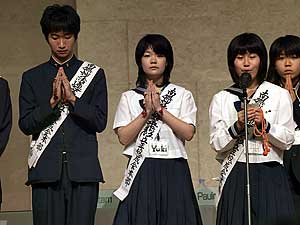
Buddhist youth offer a prayer at one of the plenary sessions.
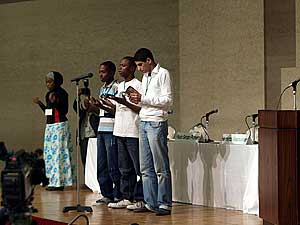
Muslim youth offer a prayer at one of the plenary sessions.
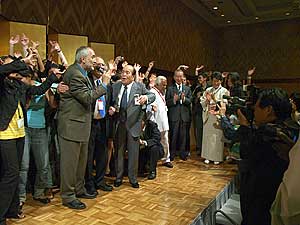
The Rev. Miyamoto, Mme. Kurenai Deguchi and others join Raffi onstage for his finale.
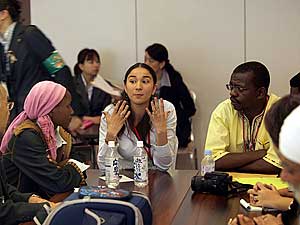
Participants share ideas during a breakout session on poverty among children.
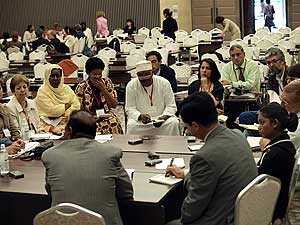
An interfaith breakout discussion focuses on violence against children.
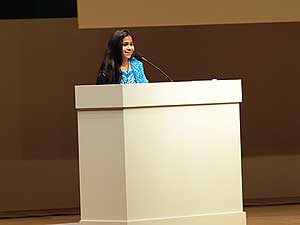
Anam Wasey of India was one of two teenagers to address the final session.
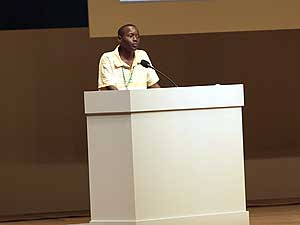
The other was Isaac Lukumayi Peter of Tanzania.
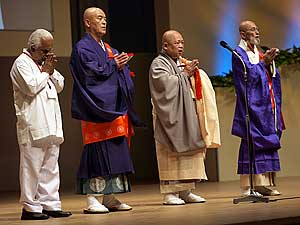
Buddhists offer prayers during the closing session.
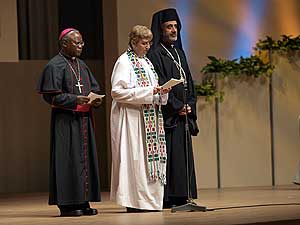
Christians offer prayers during the closing session.
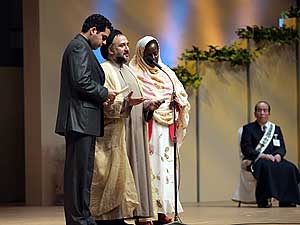
Muslims offer prayers during the closing session.
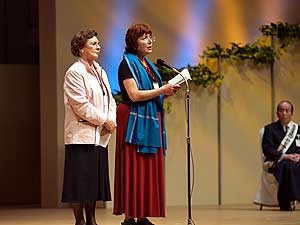
Jews offer prayers during the closing session.
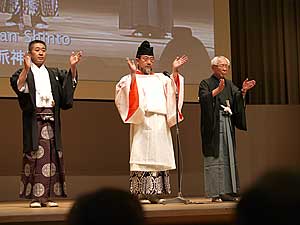
Sectarian Shinto priests, including the Rev. Kunihiko Shimamoto, the Chief Director of Oomoto (right), pray onstage.
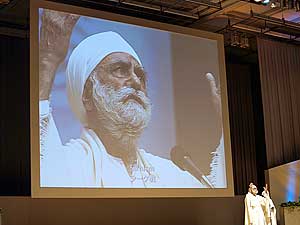
Sikhs offer prayers at the closing session.
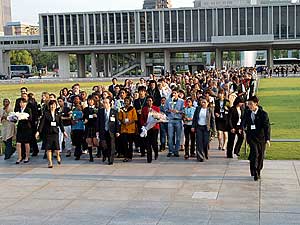
Walk for peace in Hiroshima’s Peace Park.
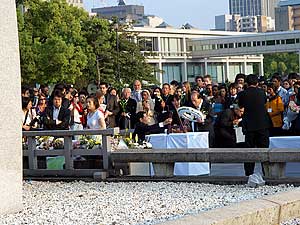
The Rev. Miyamoto places a wreath at the eternal flame.
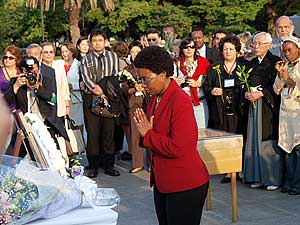
Asha-Rose Migiro, deputy secretary general of the United Nations, places a bouquet at the eternal flame.
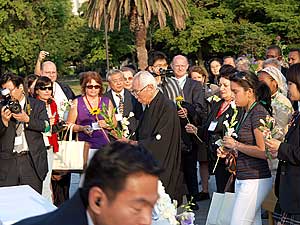
Each participant added a flower to the pile.
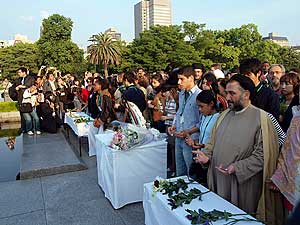
Participants place flowers and offer personal prayers for peace.
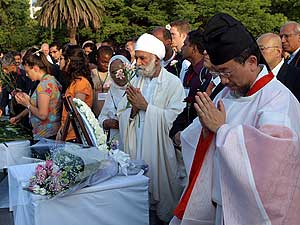
Praying for peace at the eternal flame.
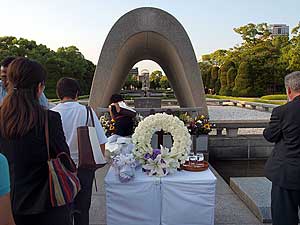
Cenotaph and eternal flame in the Peace Park.
New Contents Thu, May 20, 2010
- Oomoto participates in Sant’Egidio conference : Dialogue among religions and cultures : On divided island nation of Cyprus By Bill Roberts
- Photo Album : Portraits of three branches: Shoko, Tanegashima and Aomori By Bill Roberts
- Oomoto FAQ
- A Letter from Oomoto : Of mountains and myths By Bill Roberts
- Polyglot poem festival The Utamasturi is going international — what’s next? By Bill Roberts
- Ethics education program captures the spirit of Bankyo Dokon By Bill Roberts
- A Letter from Oomoto : A year’s worth of adventure in a summer of branch visits By Bill Roberts
- In Kumamoto, it’s all about water – and fire By Bill Roberts
- A speech by Nevada Taylor at the Kii Branch in Wakayama Prefecture on April 13, 2008.:An Encounter With Oomoto Through Aikido
- Utamatsuri, Poem Festival, in Tokyo(on April 17, 2008)
- A speech by Neil Ryan Walsh at the Kobe branch on Mar. 9th, 2008.:Planting the Seeds of the Soul
- Meeting with the Fifth Spiritual Leader of Oomoto, Madame Kurenai Deguchi by Neil Ryan Walsh
- A speech by Neil Ryan Walsh at the Nagoya branch on Feb. 17th, 2008.:The Japanese Arts beyond National Boundaries
- To the Oomoto branch in Nagoya: City of Eel and Toyota by Neil Ryan Walsh
- A Speech by Nissim Ben Shitrit, Ambassador of Israel on the occasion of the Oomoto Setsubun Grand Festival in Ayabe February 3rd, 2008 : Japan and Israel : Two Lands Balancing the Needs of Traditional Culture and Modern Life. r
- A permanent memorial to Onisaburo (A Speech at the Autumn Grand Festival , November 6, 2007 : )By James Parks Morton, Founder and Chair, Emeritus of The Interfaith Center of New York
- Israel, Palestine and the Power of Poetry(Oomoto believes small efforts can have lasting ripple effects on people and peace)By Bill Roberts
- “Something Great”(This genetics pioneer, a friend of Oomoto, offers a clue to the mystery of life)By Bill Roberts
- Kamishima Cleanup (Harima branch members regularly visit this sacred island to keep the shrine tidy)By Bill Roberts
- Kyotaro Deguchi was one of six recipients of the 2007 James Parks Morton Interfaith Award
What is Oomoto?
- What is Oomoto?
- Spirtual Centers
- Founders and Spiritual Leaders
- History
- Organization and activities
- Teachings and scriptures
- Art Works of Founders and Leaders
Opinions[Archive]
- Statement of regret for the outbreak of war against Iraq (March 20,2003)
- Jinrui Aizenkai dispatched the "Urgent Appeal for a World (Global) Crisis" on March 14.
Grappling with Bioethics[Archive]
- Oomoto’s support for abolishing the death penalty (12, June 2003)
- The Oomoto Foundation protests any birth of a human clone baby. (5, January 2003)
- OOMOTO'S VIEW REGARDING JAPAN’S PERMITION TO THE RESERCH OF HUMAN EMBRYONIC STEM CELLS (ES cells)(12, June 2000)
Vistor’s Review[Archive]
- A speech by Bill Roberts at the Oomoto branch in Hiroshima after its monthly service on March 18, 2007:Encounters with war and peace
- How Bankyo Dokon changed one life by Linda Macphee
- A speech by Bill Roberts at the Hokuriku (Kanazawa) branch on Dec. 3, 2006:Ritual and myth -an encounter with ‘divine madness’
- A speech by Bill Roberts at the Himeji Cultural Center on Feb. 25, 2007:Mesmerized by the Japanese Arts
- A speech by Bill Roberts at the Kobe branch on Feb. 11th, 2007.:There are just human tears and human joy
- A Speech on the occasion of the Oomoto Setsubun Grand Festival in Ayabe February 3rd, 2007 : Egypt's role in Middle East peace
- Keynote Speech for the 28th World Federation Japanese Religionists Conference for World Peace in Tokyo (at Kokugakuin University, Novermber 29, 2006):Vision for Peace in the Middle East By Dr. Munther S. Dajani, Professor Dean, Faculty of Arts, Al Quds University, Jerusalem
- A speech to the Kyoto branch:Spiritual adventures in researching Oomoto leaders
- A Speech at The Oomoto Foundation on Monday, November 6, 2006 : Jordan's role in Middle East By Samir Nouri, Ambassador of the Hashemite Kingdom of Jordan
- A letter from Oomoto:The Young People of Tottori
- A speech by Bill Roberts on the occasion of the dedication ceremony for the new shrine of Tottori Branch By Bill Roberts Oct. 8, 2006
- A speech by Bill Roberts at the Oomoto branch in Hiroshima after its monthly service on March 18, 2007:Encounters with war and peace
- How Bankyo Dokon changed one life by Linda Macphee
- A speech at Setsubun : A Portrait of Oomoto By Bill Roberts Feb. 3, 2006
- New Publication ! By Bill Roberts Feb. 3, 2006 A Portrait of Oomoto
you can read this book in html => http://www.jinruiaizenkai.jp/English/en-kolumno/en-bill/en-sugao/billbook1en.html
E-mail below to order brobert1@ix.netcom.com
Current Topics
- Prayer Offering and World Religious Forum II
- Living the art of dialogue
- Kyotaro Deguchi was one of six recipients of the 2007 James Parks Morton Interfaith Award
Books
Online Books
- Divine Signposts by Onisaburo DEGUCHI
- The Creation of Meaning by Hidemaru Deguchi
- Bankyo Dokon(Seventy years of Inter-Religious Activity at Oomoto)
- Nao Deguchi — A Biography of the Foundress of Oomoto
- The Great Onisaburo Deguchi published by Aiki News
- Bankyo Dokon Seventy Years of Inter-Religious Activity at Oomoto
- Insearch of Meaning
- Nao Deguchi A Biography of the Foundress of Oomoto
- A Portrait of Oomoto By Bill Roberts
Oomoto international Archive
- The History of Oomoto (Jan.– Mar. 1980 — Apr.– Jun. 1982)
- The Ancestors; Friends or Foes? (Apr.– Jun. 1987)
- Tsukinamisai; The Sabbath of Shinto (Jan.– Jun. 1983)
- The Poem Festival at Oomoto; An Ancient Rite Lives Again (Oct.– Dec. 1981)
- Purification of the Universe ; Oomoto's Setsubun Festival (Apr.– Jun. 1981)
Links
Flowers at Ten'on-kyo & Baisho-en (photographs)
Contact
All rights reserved : the Oomoto Foundation Produced by the Netinformational Commission
Since : Mar. 7.1998 Last Update : Thu, May 20, 2010
E-mail : webmaster@oomoto.or.jp
Top Page Nihongo Esperanto Português Roomazi



